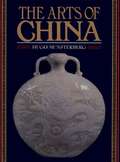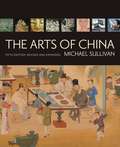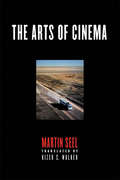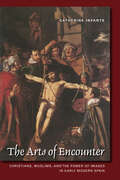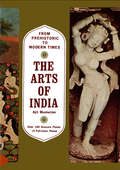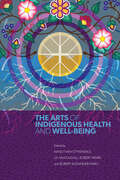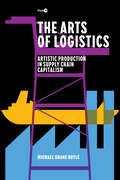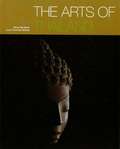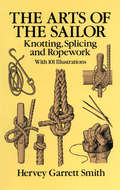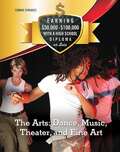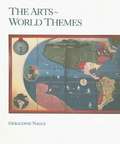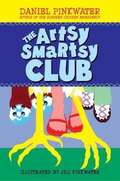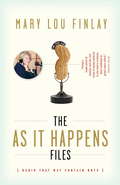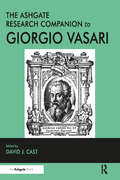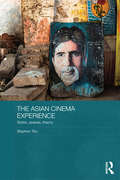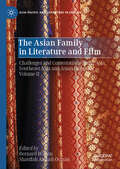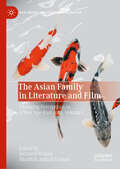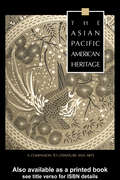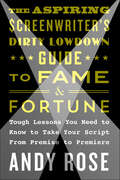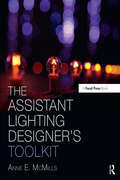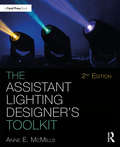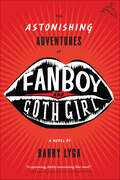- Table View
- List View
The Arts of China
by Hugo MunsterbergThe arts of China are products of the world's oldest continuous artistic tradition as well as one of its most brilliant. In this stimulating work, noted Oriental art authority Dr. Hugo Munsterberg traces the history of Chinese art dynasty by dynasty, elucidating the origins and development of major movements in painting, ceramics, bronzes, sculpture, and architecture. He clearly describes and defines the important trends and influences that culminated in the brilliant sculpture of the T'ang, the enchanting landscape paintings of the Sung, and the exquisite ceramics of the Ming. Outstanding examples of each genre are presented in over one hundred superb color and black-and-white photographs.
The Arts of China
by Hugo MunsterbergThe arts of China are products of the world's oldest continuous artistic tradition as well as one of its most brilliant. In this stimulating work, noted Oriental art authority Dr. Hugo Munsterberg traces the history of Chinese art dynasty by dynasty, elucidating the origins and development of major movements in painting, ceramics, bronzes, sculpture, and architecture. He clearly describes and defines the important trends and influences that culminated in the brilliant sculpture of the T'ang, the enchanting landscape paintings of the Sung, and the exquisite ceramics of the Ming. Outstanding examples of each genre are presented in over one hundred superb color and black-and-white photographs.
The Arts of China (Fifth Revised and Expanded Edition)
by Michael SullivanFor the fourth edition of his much-heralded The Arts of China, last published in 1984, Michael Sullivan has thoroughly revised and expanded this classic history of Chinese art from the Neolithic period to the 1990s. He draws on archaeological discoveries in the last two decades of the twentieth century that have enriched scholars' understanding of both prehistoric and ancient Chinese civilizations. At the same time, research on more recent dynasties has led to fresh interpretations of well-documented historical events and artworks. Also, China's dramatic opening to the outside world since the 1980s has triggered an explosion of contemporary Chinese art, on which Sullivan is the foremost Western authority. Written in the engaging and lucid style that is Sullivan's hallmark, The Arts of China is readily accessible to general readers as well as serious students of art history. Discussing more than three millennia of Chinese artistic endeavor, Sullivan introduces not only artworks, but also the social, political, religious, and philosophical contexts in which they were created. This fourth edition has more than 380 illustrations; many are new and nearly half are in color. With this edition Sullivan has abandoned the Wade-Giles system of romanization in favor of the official Chinese Pinyin, now widely accepted by Western readers. These improvements assure that The Arts of China will remain the most comprehensive and widely read introduction to the history of Chinese art. For the fourth edition of his much-heralded The Arts of China, last published in 1984, Michael Sullivan has thoroughly revised and expanded this classic history of Chinese art from the Neolithic period to the 1990s. He draws on archaeological discoveries in the last two decades of the twentieth century that have enriched scholars' understanding of both prehistoric and ancient Chinese civilizations. At the same time, research on more recent dynasties has led to fresh interpretations of well-documented historical events and artworks. Also, China's dramatic opening to the outside world since the 1980s has triggered an explosion of contemporary Chinese art, on which Sullivan is the foremost Western authority. Written in the engaging and lucid style that is Sullivan's hallmark, The Arts of China is readily accessible to general readers as well as serious students of art history. Discussing more than three millennia of Chinese artistic endeavor, Sullivan introduces not only artworks, but also the social, political, religious, and philosophical contexts in which they were created. This fourth edition has more than 380 illustrations; many are new and nearly half are in color. With this edition Sullivan has abandoned the Wade-Giles system of romanization in favor of the official Chinese Pinyin, now widely accepted by Western readers. These improvements assure that The Arts of China will remain the most comprehensive and widely read introduction to the history of Chinese art.
The Arts of Cinema
by Martin SeelIn The Arts of Cinema, Martin Seel explores film’s connections to the other arts and the qualities that distinguish it from them. In nine concise and elegantly written chapters, he explores the cinema’s singular aesthetic potential and uses specific examples from a diverse range of films—from Antonioni and Hitchcock to The Searchers and The Bourne Supremacy—to demonstrate the many ways this potential can be realized. Seel’s analysis provides both a new perspective on film as a comprehensive aesthetic experience and a nuanced understanding of what the medium does to us once we are in the cinema.
The Arts of EncounterThe Arts of Encounter: Christians, Muslims, and the Power of Images in Early Modern Spain (Toronto Iberic)
by Catherine InfanteImages of crosses, the Virgin Mary, and Christ, among other devotional objects, pervaded nearly every aspect of public and private life in early modern Spain, but they were also a point of contention between Christian and Muslim cultures. Writers of narrative fiction, theatre, and poetry were attuned to these debates, and religious imagery played an important role in how early modern writers chose to portray relations between Christians and Muslims. Drawing on a wide variety of literary genres as well as other textual and visual sources – including historical chronicles, travel memoirs, captives’ testimonies, and paintings – Catherine Infante traces the references to religious visual culture and the responses they incited in cross-confessional negotiations. She reveals some of the anxieties about what it meant to belong to different ethnic or religious communities and how these communities interacted with each other within the fluid boundaries of the Mediterranean world. Focusing on the religious image as a point of contact between individuals of diverse beliefs and practices, The Arts of Encounter presents an original and necessary perspective on how Christian-Muslim relations were perceived and conveyed in print.
The Arts of India
by Ajit MookerjeeThis revised and enlarged edition of The Arts of India has over 150 impressive gravure and full-color illustrations. These include various important objects and monuments not usually seen in general surveys to supplement the many essential art milestones that this book features. It is also unique in beginning its visual survey with relics of India's stone age and in concluding the book with works from the nation's great folk tradition and selected paintings by modern artists.Here is a book with captions and a text that are highly readable blends of scholarly information and informal comment by an Indian art expert. This grants the reader special insights into the concepts that lie behind art so different from that of the West.Author Mookerjee has judiciously selected photographs which present the vast panorama of Indian art from its earliest beginnings. Examples of Indian folk arts and some works by 20th-century Indian artists round out this rich historic survey of over 5,000 years of continuous creativity-a collection of paintings, reliefs, statues, and architectural monuments from this sprawling sub-continent now divided into the lands of India, Pakistan, Ceylon, Burma and Afghanistan.
The Arts of Indigenous Health and Well-Being
by Edited by Nancy Van Styvendale;J.D. McDougall;Robert Henry;and Robert Alexander InnesDrawing attention to the ways in which creative practices are essential to the health, well-being, and healing of Indigenous peoples, The Arts of Indigenous Health and Well-Being addresses the effects of artistic endeavour on the “good life”, or mino-pimatisiwin in Cree, which can be described as the balanced interconnection of physical, emotional, spiritual, and mental well-being. In this interdisciplinary collection, Indigenous knowledges inform an approach to health as a wider set of relations that are central to well-being, wherein artistic expression furthers cultural continuity and resilience, community connection, and kinship to push back against forces of fracture and disruption imposed by colonialism. The need for healing—not only individuals but health systems and practices—is clear, especially as the trauma of colonialism is continually revealed and perpetuated within health systems. The field of Indigenous health has recently begun to recognize the fundamental connection between creative expression and well-being. This book brings together scholarship by humanities scholars, social scientists, artists, and those holding experiential knowledge from across Turtle Island to add urgently needed perspectives to this conversation. Contributors embrace a diverse range of research methods, including community-engaged scholarship with Indigenous youth, artists, Elders, and language keepers. The Arts of Indigenous Health and Well-Being demonstrates the healing possibilities of Indigenous works of art, literature, film, and music from a diversity of Indigenous peoples and arts traditions. This book will resonate with health practitioners, community members, and any who recognize the power of art as a window, an entryway to access a healthy and good life.
The Arts of Logistics: Artistic Production in Supply Chain Capitalism (Post*45)
by Michael Shane BoyleWe live in a world where nothing is untouched by supply chains—art included. In this major contribution to the study of contemporary culture and supply chains, Michael Shane Boyle has assembled a global inventory of aesthetics since the 1950s that reveals logistics to be a pervasive means of artistic production. The Arts of Logistics provides a new map of supply chain capitalism, scrutinizing how artists retool technologies designed for circulating commodities. What emerges is a magisterial account of the logistics revolution that foregrounds the role played by art in the long downturn of global capitalism. With chapters on art produced from technologies including ships, barrels, containers, and drones, Boyle narrates the long history of art's connection to logistics, beginning in the transatlantic slave trade and continuing today in Silicon Valley's dreams of automation. The global reach of the artists considered reflects the geographies of supply chain capitalism itself. In taking stock of how performance, sculpture, and popular culture are entangled in trade and racialized labor regimes, Boyle profiles influential work by artists such as Christo and Allan Kaprow alongside that of contemporary figures including Cai Guo-Qiang and Selina Thompson. This incisive study demonstrates that art and logistics are linked by the infrastructures and violence that keep supply chains moving.
The Arts of Thailand
by Luca Invernizzi Tettoni Steve Van BeekFor over a thousand years, Thailand has been a cultural crossroads for the artistic traditions of India, Sri Lanka, Cambodia, and Indonesia, gradually evolving a unique style of artistic expression all its own. Based on exhaustive museum, library, and temple research, The Arts of Thailand covers every major form and period of Thai art and provides a complete overview of one of the world's richest artistic traditions.
The Arts of the Sailor: Knotting, Splicing and Ropework
by Hervey Garrett SmithOver 150 years ago, the skills needed to operate a merchant sailing vessel were many and varied. While not nearly as much in demand today as they were in the days of the Yankee clippers, these skills nevertheless remain important and necessary to today's yachtsmen and owners of smaller pleasure boats.In this excellent handbook on basic shipboard skills, marine expert Hervey Garrett Smith offers boating and yachting enthusiasts a complete course in rigging, working, and maintaining a ship. More than 100 illustrations help the reader grasp the fundamentals and fine points of handling a ship while the author describes in detail a sailor's tools, basic knots, and useful hitches as well as the arts of splicing, handsewing, and canvas work.Other topics equally important to safe, economical, and efficient boat maintenance and management include belaying, coiling, and stowing; towing procedures; how to make a chafing gear; and much more. Easy-to-follow instructions for fashioning decorative knots, ornamental coverings, and nettings, and even how to make a proper bucket round out this engaging and informative guide.Packed with useful "hands-on" information conveyed in a chatty, humorous style, The Arts of the Sailor is the perfect book to keep aboard ship for study and for ready reference when the need arises. It also makes delightful reading for armchair sailors and the legions of landlubbers with an interest in the sea.
The Arts: Dance, Music, ater, and Fine Art (Earning $50,000 - $100,000 with a High S)
by Connor SyrewiczFor many high school graduates, college is a way to get ahead, but going to college is not the only way for young adults to succeed. Many people choose to enter the workforce after high school to start earning money and gaining experience right away. These motivated young workers can have rewarding jobs without ever having to earn a 4-year college degree. If you're interested in music, theater, or art, and don't know that you want to--or can--go to college, a career in the arts might be right for you. Young people need only a high school diploma or equivalent to start work in a career in the arts, and they can eventually earn more than $50,000 a year. In The Arts: Dance, Music, Theater and Fine Art, you'll learn how to start a career in the arts and what you need to succeed in the field. Find out about the prospects for these careers in the future, how much workers can make each year, and whether your path to success includes a career in music, theater, dance, or fine art.
The Arts: World Themes
by Geraldine NagleA fresh approach to the interdisciplinary humanities course that takes a strong multicultural approach to the visual and performing arts. Organized thematically, the text covers painting, printmaking, sculpture, camera arts, architecture, music, and drama.
The Artsy Smartsy Club
by Daniel PinkwaterAfter three Hoboken children and their giant chicken Henrietta begin to appreciate beautiful sidewalk art, they venture into art class and visit Manhattan.
The As It Happens Files
by Mary Lou FinlayIn the tradition of Peter Gzowski's The Morningside Papers comes a book that celebrates the great stories and personalities behind As It Happens.For eight years, Mary Lou Finlay had the pleasure of being the co-host of one of CBC Radio's most enduring institutions. On any given day she and Barbara Budd interviewed people on subjects varying from the Air India investigation to a man who invented a suit that would withstand an attack from a grizzly bear to a cheese-rolling contest in Cheshire. The As It Happens Files gives us the great stories - the hilarious eccentrics, the audience favourites, the poignant moments - that make up, for many Canadians some of the fondest, most vivid memories of the last decade.
The Ashgate Research Companion to Giorgio Vasari (Routledge Art History and Visual Studies Companions)
by David J. CastThe Ashgate Research Companion to Giorgio Vasari brings together the world's foremost experts on Vasari as well as up-and-coming scholars to provide, at the 500th anniversary of his birth, a comprehensive assessment of the current state of scholarship on this important-and still controversial-artist and writer. The contributors examine the life and work of Vasari as an artist, architect, courtier, academician, and as a biographer of artists. They also explore his legacy, including an analysis of the reception of his work over the last five centuries. Among the topics specifically addressed here are an assessment of the current controversy as to how much of Vasari's 'Lives' was actually written by Vasari; and explorations of Vasari's relationships with, as well as reports about, contemporaries, including Cellini, Michelangelo and Giotto, among less familiar names. The geographic scope takes in not only Florence, the city traditionally privileged in Italian Renaissance art history, but also less commonly studied geographical venues such as Siena and Venice.
The Asian Cinema Experience: Styles, Spaces, Theory (Media, Culture and Social Change in Asia)
by Stephen TeoThis book explores the range and dynamism of contemporary Asian cinemas, covering East Asia (China, Japan, South Korea, Hong Kong, Taiwan), Southeast Asia (Thailand, Singapore, Malaysia), South Asia (Bollywood), and West Asia (Iran), in order to discover what is common about them and to engender a theory or concept of "Asian Cinema". It goes beyond existing work which provides a field survey of Asian cinema, probing more deeply into the field of Asian Cinema, arguing that Asian Cinema constitutes a separate pedagogical subject, and putting forward an alternative cinematic paradigm. The book covers "styles", including the works of classical Asian Cinema masters, and specific genres such as horror films, and Bollywood and Anime, two very popular modes of Asian Cinema; "spaces", including artistic use of space and perspective in Chinese cinema, geographic and personal space in Iranian cinema, the private "erotic space" of films from South Korea and Thailand, and the persistence of the family unit in the urban spaces of Asian big cities in many Asian films; and "concepts" such as Pan-Asianism, Orientalism, Nationalism and Third Cinema. The rise of Asian nations on the world stage has been coupled with a growing interest, both inside and outside Asia, of Asian culture, of which film is increasingly an indispensable component – this book provides a rich, insightful overview of what exactly constitutes Asian Cinema.
The Asian Family in Literature and Film: Challenges and Contestations-South Asia, Southeast Asia and Asian Diaspora, Volume II (Asia-Pacific and Literature in English)
by Bernard Wilson Sharifah Aishah OsmanThis book investigates the ways in which the family unit is now perceived in South and Southeast Asia and the Asian diaspora: its numerous conceptions and the changes it has undergone over the last century and into the new one. The prevailing threads that run through a significant part of the literature and cinema emerging from these societies are the challenges that confront those negotiating changing forms of family, changes which are expressed historically, politically, and socio-culturally, and often in relation to gender, ethnic, or economic imbalances. Though regional and localized in many ways, they are also very much universal in the questions they ask, the lessons they teach, and the connections they make. Theoretically, and in terms of focus, the collection offers a broad range, embracing representation and analysis from scholars across the globe and across disciplines. It assembles written and visual texts from and about India, Indonesia, Malaysia, The Philippines, Singapore, and the Asian diaspora. How have more fluid concepts of family in the late twentieth and early twenty-first centuries affected the understanding of family in Asia? How have families in Asia resisted or embraced change? How have they responded to trauma? What do other readings—gendered, feminist, queer, and diasporic—bring to modern debates surrounding family? To what extent are notions of family, community, society, and nation represented as interchangeable concepts in Asian societies? This book questions the power dynamics, ethical considerations, and moral imperatives that underpin families and societies within, and beyond, Asian borders.
The Asian Family in Literature and Film: Changing Perceptions in a New Age-East Asia, Volume I (Asia-Pacific and Literature in English)
by Bernard Wilson Sharifah Aishah OsmanThis book offers a key analysis of the changing perceptions of family in East Asian societies and the dynamic metamorphosis of “traditional” family units through the twentieth century and into the new millennium. The book focuses on investigations of the Asian family as it is represented in literature, film, and other visual media emerging from within China, Japan, South Korea, and Taiwan, and on contestations of the power hegemonies and moral codes that underpin such representations, while also assessing Western and global influences on the Asian family. Individually and collectively, these essays examine traditions and transformations in the evolving conception of family itself and bring together a range of scholars from within and beyond the region to reflect upon the social and cultural mores represented in these texts, the issues that concern Asian families, and projections for future families in their own societies and in a globalized world. Through the written text and the lens of the camera, what directions has the understanding of family in an Asian context taken in the twenty-first century? How have the multiple platforms of media represented, encouraged, or resisted transitions during this time? Amid broader and mutating referential frameworks and cross-cultural influences, is the traditional concept of the “nuclear family” still relevant in the twenty-first century? This book lends further prominence to the diverse literary and cinematic production within East Asia and the eclectic range of media used to represent these ideas. It will be essential reading for scholars of literature, film studies, and Asian studies, and for those with an interest in the cultural and sociological implications of the changing definitions and parameters of the family unit.
The Asian Pacific American Heritage: A Companion to Literature and Arts (Reference Library Of The Humanities #Vol. 2109)
by Peter Bacho Amy Ling Daniel Gonzales Evelyn Hu-Dehart George J. Leonard Jeffery Chan Leo Chen David Hyun S. E. SolbergMeeting the challenge of teaching multiculturalismStudents-and their teachers-encountering literature and arts from unfamiliar cultures will welcome the special help this book provides. Instructors who are unfamiliar with Asian Pacific cultures are now being asked to explain a reference to the Year of the Rat, Obon Season, or to interpret a haiku. When Amy Tan refers to the Moon Lady or the Kitchen God, what does she mean? Is Confucianism actually a religion? This book answers these and many other questions, for students, teachers, and the librarians to whom they turn for help.Provides sound information on in-demand topicsThe Companion presents lengthy articles-written specifically for this book-on the topics that unlock the work of a number of contemporary Asian Pacific American writers and artists, for example: Asian naming systems, the "model minority" discourse, Chinese diaspora, Filipino American values, the Confucian family and its tensions, Japanese internment, Mao's Great Cultural Revolution, the Korean alphabet, food and ethnic identity, religious traditions, Fengshui and Chinese medicine, Filipino folk religion, Hmong needlework, and reading Asian characters in English, just to name a few.Covers major contemporary writersThe articles are coupled with in-depth studies of the authors most likely to be part of the multicultural curriculum during the next decade, among them Maxine Hong Kingston, Frank Chin, Amy Tan, Younghill Kang, Carlos Bulosan, Jessica Hagedorn, Lawson Fusao Inada, Garret Hongo, David Henry Hwang, Kim Ronyoung, and Cathy Song.Expert contributorsThis volume was created under the supervision of distinguished Advisory Editors from the Asian Pacific American community. The contributors, a Who's Who of Asian Pacific American humanistic scholarship, are frequently the founders of their disciplines, and most are from the ethnic group being written about.Helps students understand arts and literatureMulticultural courses are generally taught by exposing students to literature or arts, with reference to their political, sociological, and historical contexts. This book is designed to help students reading novels, watching films, and confronting artworks with information needs quite different from those of social scientists and historians.
The Aspiring Screenwriter's Dirty Lowdown Guide to Fame and Fortune: Tough Lessons You Need to Know to Take Your Script from Premise to Premiere
by Andy RoseA humorous and pithy guide to the craft of writing a screenplay and the business of being a screenwriter.Seeing your name on the silver screen beneath the words "Written By" is a moment most writers only dream of. But for those daring and talented few, brave enough to take their hopes to Hollywood, there are clear and tangible steps to achieve that goal if one knows the path. The Aspiring Screenwriter's Dirty Lowdown Guide to Fame and Fortune provides that path. And Andy Rose has walked it.With years of experience with every major film studio and network, and dozens of successful screenplays, Andy knows the business. He’s here to debunk the big screen and teach you how to write a blockbuster screenplay and equally important, how to sell it.Andy has worked with the best: Ron Howard, Tom Hanks, David Geffen, and Jeff Katzenberg to name a few. He has filled this book with real life examples to learn from including contracts, screenplays, treatments, press, and more. For anyone who’s ever dreamed of writing a screenplay, for anyone who’s wondered how to sell one, this is a must read.
The Assistant Lighting Designer's Toolkit (The Focal Press Toolkit Series)
by Anne E. McMillsWhat are the do’s and don’ts of being a good assistant lighting designer? What are focus tapes, and how do I use them? What is the best method for creating a magic sheet? What should be found in every assistant’s kit? How do I make that first important leap into this professional career? Answer these questions and many more with The Assistant Lighting Designer’s Toolkit. This definitive guide unlocks the insider-secrets used to succeed as a professional assistant lighting designer (ALD) – whether choosing assisting as a career or while transitioning to another. This book outlines, step-by-step, the challenges the ALD faces during every phase of production. Never before has a resource existed that views the design process through the eyes of the assistant. Intermingled among the nuts and bolts of the paperwork and essential procedures, top industry professionals reveal tips for personal survival in this challenging career – both domestically and abroad as well as in other careers in lighting. Within these pages are the industry secrets rarely taught in school! The author's website can be found at http://www.aldtoolkit.com/.
The Assistant Lighting Designer's Toolkit (The Focal Press Toolkit Series)
by Anne E. McMillsThe ground-breaking text that took the lighting world by storm returns in its second edition, unlocking the insider secrets and proven, time-tested methods to succeed as a professional assistant lighting designer. This definitive guide outlines, step-by-step, the daily challenges that assistant lighting designers face during every phase of production, and the solutions for overcoming them. Furthermore, intermingled among the highly detailed paperwork techniques and essential procedures, top industry professionals reveal tips for success in this challenging career. This fully updated second edition features: All new advice, real-world stories, and current paperwork examples from over 120 working professionals. Updated industry practices with case studies from the professionals themselves, such as how to create a video network to record previews for the lighting department; how much printing is done in an increasingly paperless world; how to produce a set electrics package; and how the industry interfaces with cutting-edge technology like remote followspots and pre-visualization software. New lifestyle tips for traveling abroad, negotiating contracts, and dealing with stressful situations. The Assistant Lighting Designer's Toolkit, the most trusted authority on assisting in the lighting world, equips budding assistant lighting designers and students studying lighting design with the insider knowledge they need to achieve the successful career that they have always wanted—whether choosing assisting as a career or as a stepping-stone toward design. Within these pages are the industry secrets rarely taught in school!
The Astonishing Adventures of Fanboy and Goth Girl: A Novel
by Barry LygaFanboy has never had it good, but lately his sophomore year is turning out to be its own special hell. The bullies have made him their favorite target, his best (and only) friend seems headed for the dark side (sports and popularity), and his pregnant mother and the step-fascist are eagerly awaiting the birth of the alien life form known as Fanboy's new little brother or sister. Fanboy, though, has a secret: a graphic novel he's been working on without telling anyone, a graphic novel that he is convinced will lead to publication, fame, and--most important of all--a way out of the crappy little town he lives in and all the people that make it hell for him. When Fanboy meets Kyra, a.k.a. Goth Girl, he finds an outrageous, cynical girl who shares his love of comics as well as his hatred for jocks and bullies. Fanboy can't resist someone who actually seems to understand him, and soon he finds himself willing to heed her advice--to ignore or crush anyone who stands in his way.
The Astors
by Harvey O'ConnorThe Astors is a comprehensive biography of one of the most prominent and influential families in American history. The Astors were a wealthy and powerful family who made their fortune in the fur trade and real estate, and went on to become one of the most influential families in New York City and beyond. This book traces the history of the Astor family from its humble beginnings in Germany to its rise to prominence in America and explores the lives of some of its most famous members, including John Jacob Astor, William Waldorf Astor, and Brooke Astor. It delves into their personal lives, business ventures, and philanthropic endeavors, and sheds light on the family's role in shaping the cultural and economic landscape of America. Harvey O’Connor’s meticulously researched and engagingly written book, which includes numerous family photos and a thorough genealogy, offers a fascinating glimpse into the lives of one of America's most iconic families. It is a must-read for anyone interested in American history, business, and culture.Also available in audiobook format.
The Astro Boy Essays
by Frederik L. SchodtThe pioneering genius of Japan's "God of Comics," Osamu Tezuka (1928-89), is examined through his life's masterwork: Tetsuwan Atomu, also known as Mighty Atom or Astro Boy, a comic series featuring a cute little android who yearns to be more human. The history of Tetsuwan Atomu and Tezuka's role in it is a road map to understanding the development of new media in Japan and the United States. Topics include Tezuka's life, the art of animation, the connection between fantasy robots and technology, spin-offs, and Astro Boy's cultural impact.Frederik L. Schodt is a translator and author of numerous books about Japan, including Manga! Manga! and Dreamland Japan. He often served as Osamu Tezuka's English interpreter. In 2009 he was received the The Order of the Rising Sun, Gold Rays with Rosette for his contribution to the introduction and promotion of Japanese contemporary popular culture.
